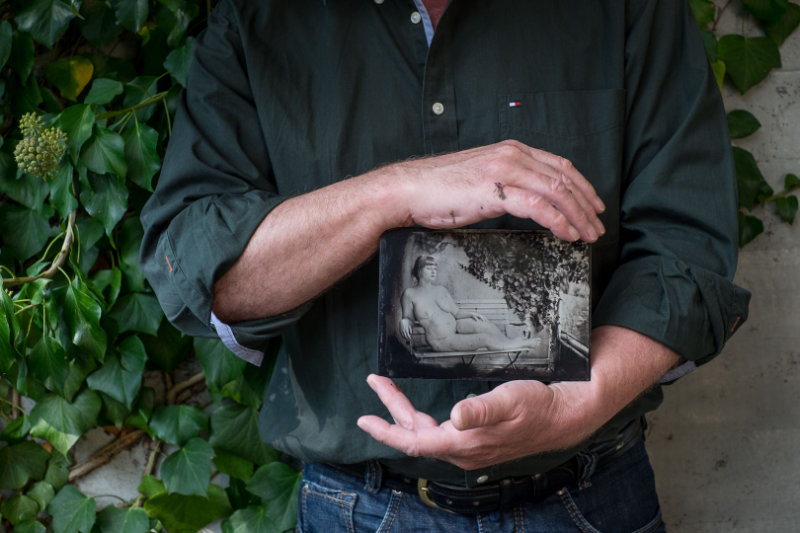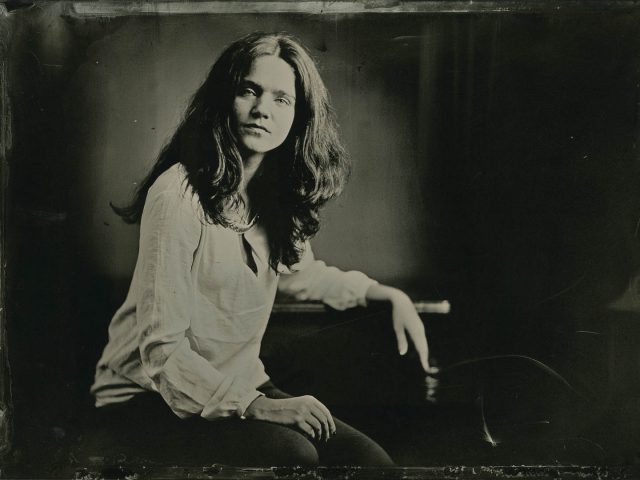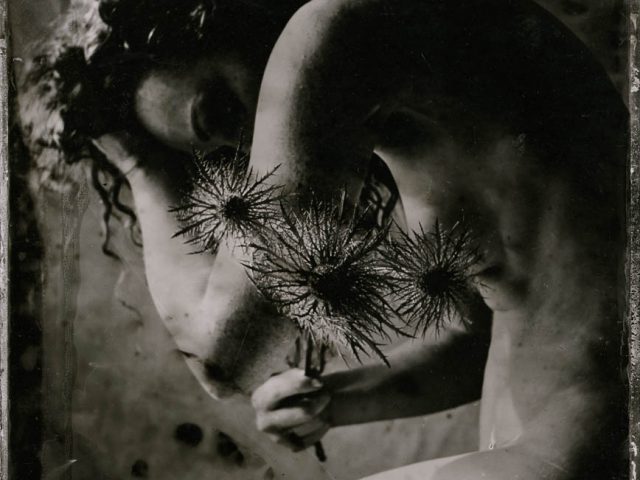A while ago I travelled to Baden-Baden to meet Robert Reis , who exhibited his great portraits there. I had in my backpack a small package with pictures which I wanted to show him. On the way I passed a nowadays rare photographic shop which had some old photographs on display, among others this treasure in a bautiful velvet lined casing.
It is a handcoloured ferrotype, probably made between 1851 and 1890. When I bought this photo, the owner talked enthusiastically about this old technique. I took my box out of the backpack and asked him: "Guess what is in here". It contained some of my ferrotypes, and we had a lengthy conversation after that.
Practice makes perfect
I work for quite a while now with these ferrotypes. They are one of the collodion wet plate varieties which were the conventional photographic technique from mid to end of the 19th century. The method was published by Frederick Scott Archer in 1851 and revolutionized photography due to its shorter exposure times, but by today's standards it is not at all senstive. At about 3 ASA, even with very bright light, exposure usually requires several seconds during which the model must not move.
But the models are not unhappy with this. While the technique is a bit elaborate, it has also some fascination. This starts already with sensitizing the picture carrier - a black aluminium plate - which must be done in a darkroom just before exposure. It has to be further processed before it dries - hence the name wet plate. During this, the picture is hardly visible first in the red darkroom light, but it clears slowly to reveal the final picture. It is a magical moment, which fascinates also many models.
Despite that these are really aluminotypes, they are usually referred to as ferrotypes. While gaining experience with this process I had to learn a lot, much more than with any other historical process I employed so far. Many plates which I would like to have were lost for one reason or another. For example, my very first plate was almost without faults - up to the moment where I applied a protective varnish for conservation. The picture dissolved in seconds and was gone. While I am disappointed by the loss of this and other pictures, this is also part of the learning process which helps for better understanding of the process.
Besides taking pictures in the studio I empoy this technique also outside - currently only within reach of my darkroom, though. Depending on the light expose may be up to 10 seconds here as well. Usually, this requires the use of a headrest behind the model, but these pictures were made without such aid.
Mir geht es gar nicht um so perfekte Technik wie sie auf meiner in Baden-Baden erstandenen Ferrotypie zu sehen ist. Imperfektion und bis zu einem gewissen Grad auch Fehler gehören für mich dazu. Wenn ich das nicht wollte, könnte ich auch gleich meine Digitalkamera nehmen; die macht es meist perfekt, auch wenn ich das gar nicht will. Meine historischen Objektive und meine wooden camerawhich I used to make these plates are as far away from it as possible.
The end of the historic technique
The end of this technique at about 1880 is owed to George Eastman . He worked with collodion wet plates, as usual at the time. Much to his anger, he ruined his clothing with silver nitrate solution which is required to make collodion wet plates. Anything which comes into contact with this solution gets black - not only clothing but also skin. It is mandatory, therefore, to wear safety glasses and rubber gloves when making wet plates. Eastman took this as an opportunity to finalize the development of dry plates and founded a company named "The Eastman Kodak Company". From then on, it was no longer necessary to work with chemicals which leave persistant stains particularly with beginners (that's why you see this on the picture at top). That's black magic.
The wet plate Voodoo
I may happen that it does not work well during a shooting. It is tempting then to search for possible causes in the internet, and I found one: it is the wet plate Voodoo. The recommendation was to stop and continue on the next day - the Voodoo disappears until then. Sometimes you really can not find another cause than this.
I like to thank my models for their interest in this technique, and also for their patience which is often reauired. This is especially true for the Masked who can be seen in the pictures and contributed much to my development so that I can work today reasonably confident with wet plates. For our first ferrotypes, she held the pose for about 30 seconds - without a headrest! A masterpiece which I still admire. The wet plate Voodoo still exists, but he comes rather rarely. He can be seen on one of my pictures with Zetze.
Further collodion wet plates can be cound in several of my stories and in my portfolio albums:



Tell us about your thoughtsWrite message